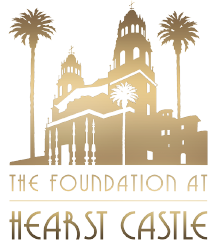Giving can help make the world a better place for us, our children, and future generations. No matter how you choose to give to The Foundation at Hearst Castle, you’ll be supporting the ongoing conservation of this historic landmark and helping us provide innovative education programs to underserved students.
Additionally, a well-structured charitable plan can provide benefits to the causes you care about for generations to come. What follows is an introduction to different charitable giving strategies, including some of the financial and estate-planning issues associated with them. Our team of advisors can work with your attorney and tax advisor to help you make the most of these strategies.
FREQUENTLY ASKED QUESTIONS
Q: What is a direct gift to charity?
A: You can make an outright gift during your lifetime or leave it through your will as a bequest. Direct gifts to charity include various types of assets, such as cash and securities. A gift to a capital campaign is one example of a popular type of direct gift.
Q: Will I receive a deduction for my direct gift?
A: Direct lifetime gifts may entitle you to a charitable income tax deduction, depending on your income level. For those whose income level qualifies, deductions are generally allowed for up to 60% of the donor’s adjusted gross income (AGI), assuming the gift is cash and made to a public Charity. Gifts of long-term appreciated property offer potential deductions of up to 30% of AGI. Any part of the deduction that cannot be used in the year the gift is made can be carried forward for up to five years. A large direct gift may provide a gift tax deduction equal to the fair market value of the gift. Deduction limits may differ for gifts to private foundations.
Q: What are the benefits of using life insurance to give to charity?
A: Life insurance provides leverage when gifting, which makes it possible to gift a significant amount at a relatively small cost.
Q: What are split-interest vehicles and how do they benefit donors?
A: Split-interest vehicles are used to designate two beneficiaries: a current beneficiary and a remainder beneficiary. The current beneficiary receives an annual payout stream from the trust, typically you during your lifetime. The remainder beneficiary receives the assets left in the trust at the conclusion of its term.
Here is a description of the four major types of split-interest vehicles:
CHARITABLE GIFT ANNUITIES
A charitable gift annuity is a special type of agreement designed to provide you with the benefits of a traditional annuity while giving the underlying asset to charity. In exchange for a gift of cash or securities (some states allow the gift of closely held stock or property), you would receive annuity payments for life from your selected charity. The lifetime annuity payments. Learn more.
POOLED-INCOME FUNDS
A pooled income fund allows you to “pool” together cash or securities to create one large gift for charity. The charity then reinvests these assets as a pool. The fund’s annual income is paid to you or your beneficiaries, based on your share and/or each beneficiary’s share of the pool. Upon the death of the fund’s beneficiary or beneficiaries, the remaining share of the pool is transferred to the charity.
CHARITABLE REMAINDER TRUSTS
A charitable remainder trust (CRT) is a tax-advantaged vehicle that enables
you, as the donor, to give to charity, diversify assets and receive annual payouts. If you have been holding onto appreciated assets for fear of paying a high capital gains tax, you could transfer the assets to a CRT and possibly avoid immediate capital gains on the transfer. In addition, the trust would provide you with any annual payout stream. At the end of the payout term, the remainder of the assets would be left to charity.
Creating a CRT could provide you with an income tax deduction as well. The deduction would be based on the fair market value of the gift, less the present value of your payout stream. It would also be determined by the nature of the gift, the type of charity receiving the gift and your AGI. There may be income tax due on the annual payouts to you. As the donor, you determine the term of the trust, which can last for your lifetime, or for a fixed term of up to 20 years. You can also choose the level of annual payouts to be paid by the trust. Typically, the maximum payout rate depends upon the length of the trust or the life expectancies of the income recipients, but it cannot exceed 50%; the minimum payout is 5%, either as a fixed sum or a fixed percentage. When your payout term ends (often at death), whatever is left in the trust is distributed to the charity (or charities) of your choice. Learn more.
CHARITABLE LEAD TRUSTS
Charitable lead trusts (CLTs) are generally more attractive in periods of low interest rates. A CLT works as follows: You would fund the trust, preferably with an asset expected to appreciate; the charity receives a fixed annual payout from the trust; and the remainder goes to your beneficiaries at the end of the charity’s payout term. The primary benefit of a CLT lies in its gift tax consequences. The value of the donor’s initial gift to the trust is determined by a government-set rate, the term of the trust and the payout to charity. When the government-set rate is low, the value of the donor’s gift is reduced for gift tax purposes. Unlike charitable remainder trusts, CLTs are not tax-exempt entities. Depending on the type of CLT, you may be able to take a charitable income tax deduction at the time you make the gift; either you, as the donor, or the trust must pay capital gains tax when the charity sells the trust assets; or you or the trust must pay income tax on any income generated in the trust. Learn more.
Q: Can I make provisions for my family and give significant assets to charity?
A: One concern that many donors have in gifting significant assets to charity is that the assets will no longer be available for the family. The following technique may help to ensure the family will be left with an inheritance, too: Using the savings from your charitable income tax deduction and any payouts received from one or a combination of the charitable vehicles discussed, you can gift an annual amount to an irrevocable life insurance trust. The trust would purchase a life insurance policy on your life. At death, the life insurance proceeds could be distributed to the trust’s family members. Assuming the trust is established correctly (mainly, that you hold no ownership interest in the life policy), the proceeds are not taxed for income or estate tax purposes.
ResourcesStrategies for Charitable Giving Charitable Giving at a Glance: A Quick Reference Guide Call Director of Development Tara Stephenson at (805) 927-2138 or email tara@foundationathearstcastle.com. |







